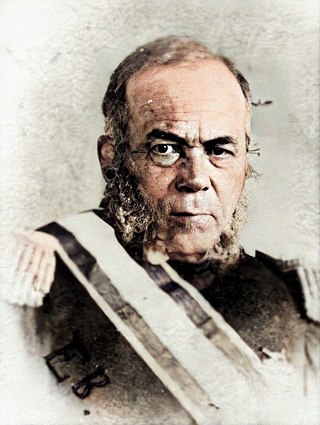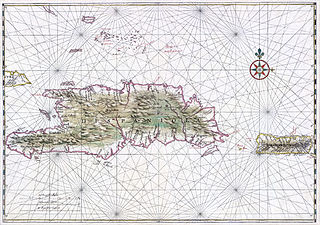
El Seibo, alternatively spelt El Seybo, is a province of the Dominican Republic. Before 1992 it included what is now Hato Mayor province.

Juan Pablo Duarte y Díez was a Dominican military leader, writer, activist, and nationalist politician who was the foremost of the Founding Fathers of the Dominican Republic and bears the title of Father of the Nation. As one of the most celebrated figures in Dominican history, Duarte is considered a folk hero and revolutionary visionary in the modern Dominican Republic, who along with military generals Ramón Matías Mella and Francisco del Rosario Sánchez, organized and promoted La Trinitaria, a secret society that eventually led to the Dominican revolt and independence from Haitian rule in 1844 and the start of the Dominican War of Independence.

Francisco del Rosario Sánchez was a Dominican revolutionary, politician, and former president of the Dominican Republic. He is considered by Dominicans as the second prominent leader of the Dominican War of Independence, after Juan Pablo Duarte and before Matías Ramón Mella. Widely acknowledged as one of the Founding Fathers of the Dominican Republic, and the only martyr of the three, he is honored as a national hero. In addition, the Order of Merit of Duarte, Sánchez and Mella is named partially in his honor.

Pedro Santana y Familias, 1st Marquess of Las Carreras was a Dominican soldier and politician who served three times as the president of the First Dominican Republic (1844–1861) and was the first governor-general during the period of annexation of the Dominican Republic to Spain (1861–1865), accomplished at Santana's request. Called "Libertador de la Patria" in life, Santana is today considered a dictator because of his authoritarian rule.

The Dominican War of Independence was a war of independence that began when the Dominican Republic declared independence from the Republic of Haiti on February 27, 1844 and ended on January 24, 1856. Before the war, the island of Hispaniola had been united for 22 years when the newly independent nation, previously known as the Captaincy General of Santo Domingo, was unified with the Republic of Haiti in 1822. The criollo class within the country overthrew the Spanish crown in 1821 before unifying with Haiti a year later.

Spanish reconquest of Santo Domingo was the war for Spanish reestablishment in Santo Domingo, or better known as the Reconquista, and was fought between November 7, 1808, and July 9, 1809. In 1808, following Napoleon's invasion of Spain, the criollos of Santo Domingo revolted against French rule, which caught the attention of British forces, who were engaging in other campaigns in the Caribbean. The struggle culminated in 1809 with a return to the Spanish colonial rule for a period commonly termed España Boba.

The Battle of Palo Hincado was the first major battle of the Spanish reconquest of Santo Domingo of the Spanish colonial Captaincy General of Santo Domingo, that was occupied by the French in the Spanish West Indies. The site is in the present-day Dominican Republic, on the island of Hispaniola in the Caribbean.

The Haitian occupation of Santo Domingo was the annexation and merger of then-independent Republic of Spanish Haiti into the Republic of Haiti, that lasted twenty-two years, from February 9, 1822, to February 27, 1844. The part of Hispaniola under Spanish administration was first ceded to France and merged with the French colony of Saint Domingue as a result of the Peace of Basel in 1795. However, with the outbreak of the Haitian Revolution the French lost the western part of the island, while remaining in control of the eastern part of the island until the Spanish recaptured Santo Domingo in 1809.

In the history of the Dominican Republic, the period of España Boba lasted from 9 July 1809 to 1 December 1821, during which the Captaincy General of Santo Domingo was under Spanish rule, but the Spanish government exercised minimal powers because its resources were attenuated by the Peninsular War and the various Spanish American wars of independence. The period ended when Dominican officials declared a short-lived independence on 30 November 1821. In February 1822, Haiti annexed former Santo Domingo, leading to an occupation that lasted until 1844.

In the history of the Dominican Republic, the period of Era de Francia occurred in 1795 when France acquired the Captaincy General of Santo Domingo, annexed it into Saint-Domingue and briefly came to acquire the whole island of Hispaniola by the way of the Treaty of Basel, allowing Spain to cede the eastern province as a consequence of the French Revolutionary Wars.

The Annexation of the Dominican Republic to Spain or Reintegration of Santo Domingo was a brief period in 1861-1865 during which the Dominican Republic returned to the sovereignty of Spain, following the request of the Dominican government and its president, Pedro Santana. The period coincided with the American Civil War, during which the United States was unable to enforce the Monroe Doctrine. After fighting an insurgency of two years in the Dominican Restoration War, Spain left the country in 1865. Some Dominicans that left with Spain later fought in Cuba's independence wars, most notably Máximo Gómez.

Juan Sánchez Ramírez was a Dominican general who was the primary leader of the War of Reconquista. He is known for leading the troops in the Battle of Palo Hincado. The decisive Dominican victory resulted in the end of French rule in eastern Hispaniola in 1809. He was the first Dominican to serve as governor of Santo Domingo.

Pablo Alí was a chief military commander of African origin, who was in charge of the so-called Battalion 31 or Batallon de Morenos, freed slaves which joined the ranks of the Dominican army. Alí directed the battalion to participate in the Italian rebellion of 1810, during the government of Juan Sánchez Ramírez. He was said to have been "most prominent, achieving great military distinction in Santo Domingo".

Dominican Republic–Haiti relations are the diplomatic relations between the nations of Dominican Republic and Haiti. Relations have long been hostile due to substantial ethnic and cultural differences, historic conflicts, territorial disputes, and sharing the island of Hispaniola, part of the Greater Antilles archipelago in the Caribbean region. The living standards in the Dominican Republic are considerably higher than those in Haiti. The economy of the Dominican Republic is ten times larger than that of Haiti. The migration of impoverished Haitians and historical differences have contributed to long-standing conflicts.

The Beheadings of Moca was a massacre that took place in Santo Domingo in April 1805 when the invading Haitian army attacked civilians as ordered by Jean-Jacques Dessalines and Henri Christophe, during their retreat to Haiti after the failed attempt to end French rule in Santo Domingo. The event was narrated by survivor Gaspar Arredondo y Pichardo in his book Memoria de mi salida de la isla de Santo Domingo el 28 de abril de 1805 , which was written nearly 40 years after the massacre is said to have taken place. The broader invasion was part of a series of Haitian invasions into Santo Domingo, and occurred after the return from the Siege of Santo Domingo (1805). Haitian historian Jean Price-Mars wrote that the troops killed the inhabitants of the targeted settlements irrespective of race.

Jean-Louis Ferrand was a French Army officer and colonial administrator who served as the governor of Santo Domingo from 1803 to 1808. Seeing action during the American Revolutionary War and the French Revolutionary Wars in the French Army, he joined the Saint-Domingue expedition which unsuccessfully attempted to restore French rule and slavery in the colony of Saint-Domingue. Unwilling to capitulate to the Indigenous Army, Ferrand retreated into the neighboring Captaincy General of Santo Domingo and began serving as its governor, successfully resisting a Haitian invasion in 1805. By 1808, the Peninsular War resulted in the Spanish reconquest of Santo Domingo, and Ferrand committed suicide during the Battle of Palo Hincado, bringing an end to French rule in the colony.
Joseph-David de Barquier was a French commander from the French Revolution. He would later take part in the affairs of the island of Hispaniola. The two occupying colonies of Saint-Domingue and Santo Domingo would each undergo their own revolutions against France: the Haitian Revolution and the Spanish reconquest of Santo Domingo. As successor of Jean-Louis Ferrand, he continued the fight against Dominican insurgents under Juan Sánchez Ramírez in the latter conflict. But with the aid of British forces in Jamaica, the rebels defeated France, leaving de Barquier with no choice but to capitulate in 1809.
Ciriaco Ramírez was a Dominican military man, landowner and revolutionary. Materialist history presents him as a precursor of independence thought during the Reconquista War in Santo Domingo, however, there is not a single document that proves it. His activities following the war against France remains unknown. While some historians say that Ciriaco was imprisoned and confined to Ceuta for his independence activity, where he supposedly died, this shows that perhaps during the period known as España Boba, he was an officer in the army of the Spanish colony of Santo Domingo.

The 1812 Mendoza and Mojarra conspiracy was a slave movement that transpired in Santo Domingo, in the heat of the proclamation of the Cadiz Constitution, in 1812. This movement, led by free blacks, sought to overthrow the colonial government in Santo Domingo, with the intention of merging Santo Domingo with neighboring Haiti.

















